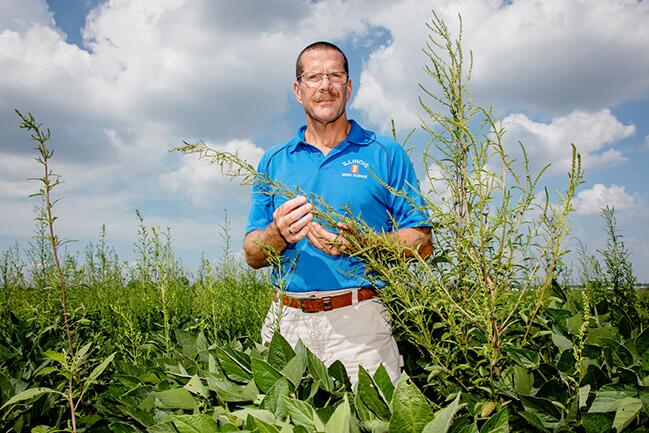Tank-mixing herbicides may not be enough to avoid herbicide resistance

URBANA, Ill. — Eight years ago, University of Illinois and USDA-ARS scientists turned weed control on its head. More and more herbicide resistant weeds were popping up, and the pest plants were getting harder to kill. It was clear farmers could no longer rely on the same chemicals year after year. Industry campaigns and herbicide applicators began touting the benefits of rotating herbicides annually to avoid developing resistance, and rotation quickly became common practice.
But in 2015, a team of weed scientists from U of I and USDA-ARS studied the effects of herbicide rotation and found the practice actually increased resistance to glyphosate in waterhemp, a common and destructive Corn Belt weed. What worked, instead, was mixing multiple herbicides in the same tank and spraying simultaneously. Their large experiment, including 105 grain fields across Illinois, showed tank-mixing was 83 times less likely to lead to glyphosate resistance.
The study had a powerful impact, with recommendations changing nearly overnight; tank-mixing herbicides is now de rigueur. But one of the study’s authors is now urging farmers and industry players to remember tank-mixing only delays the evolution of resistance.
“I worry this practice has become overused. It’s too simplistic to think all you need to solve the challenges of resistance is to go on using herbicides but in a slightly different way,” said Aaron Hager, weed scientist and faculty Extension specialist in the Department of Crop Sciences, part of the College of Agricultural, Consumer and Environmental Sciences (ACES) at Illinois. Hager wrote about the topic in a new farmdoc article.
He notes waterhemp is now resistant to herbicides from at least seven herbicide modes of action, despite the advantages of tank-mixtures. And some waterhemp populations are resistant to herbicides to which they have never been exposed. In other words, herbicide resistance is a complex and fast-moving target. And we’re not keeping up.
Speaking of targets, Hager notes the 2015 study focused on one type of herbicide evasion strategy: target-site resistance. That’s when the weed’s genetic code mutates such that the chemical no longer fits in the protein receptor – target site – it’s designed to attack.
More often nowadays, including in the case of waterhemp developing resistance to a chemical it had never before seen, weeds are using another strategy. It’s known as metabolic or non-target site resistance. Here, weeds ramp up production of detoxifying enzymes that render herbicides useless before they can kill the plant.
“As far as we know, there are no data testing the hypothesis that herbicide mixtures are the most effective way to avoid the evolution of non-target site-based resistance mechanisms,” Hager said. “Without those data, how do we know which herbicides or what combinations remain effective against any waterhemp population? There is no simple way to know.”
Hager emphasizes that the problem of resistance to herbicides is the direct result of over-reliance on a single, simple solution: chemical weed control. The problem, in his view, won’t be solved by exclusively using the same tools, but in different ways. Instead, he says farmers should diversify tactics and focus on preventing or eliminating weed seed production.
“Look, herbicides will continue to be valuable tools to help prevent crop yield loss, but we also must consider additional tactics to ensure no waterhemp plant is allowed to produce seed during the growing season. All we know with certainty is that if plants can’t produce seed, the frequency of any resistance mechanism can’t change or grow. Even a few seed-bearing waterhemp plants remaining in the field at harvest could contain the newest herbicide-resistance mechanism,” Hager said. “It’s worth repeating: consider additional tactics to ensure no weed seed production.”